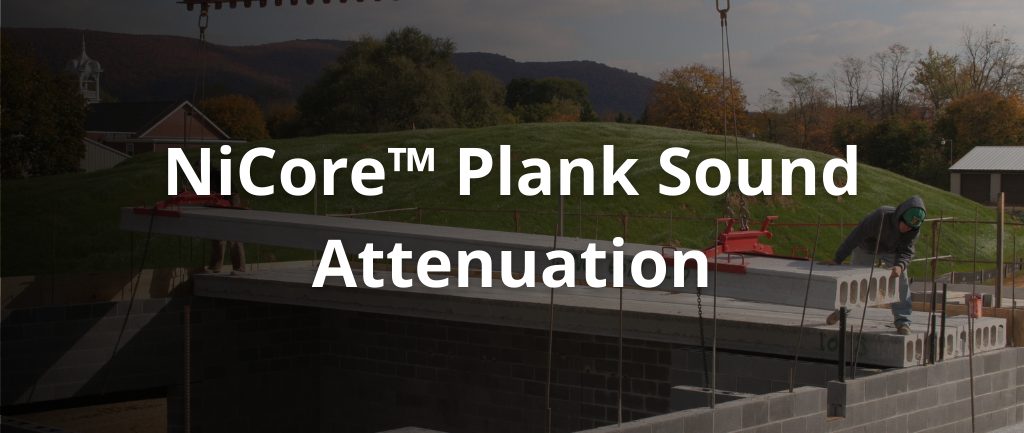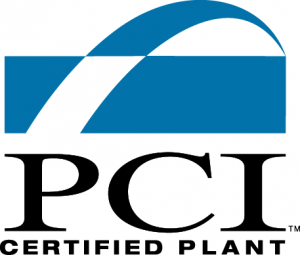
Precast, prestressed hollow-core slabs have been reliable and frequently chosen construction components for over fifty years. Designers, contractors, and owners appreciate their high-performance benefits such as year-round construction, fast-track site erection, low maintenance, and long-term durability, making them a preferred choice for floor and roof construction in hotels, apartments, schools, dormitories, and condominiums. Machine casting of hollow-core slabs provides high quality, mass production, and value pricing.
NiCore™ Plank Sound Attenuation
An often-overlooked feature of NiCore™ Planks from Nitterhouse Concrete Products, Inc. (NCP) is their excellent airborne sound attenuation, a very distinct advantage over structures constructed with wood framing where sounds from surrounding occupied spaces can be rather disturbing. Hotels, apartments, and dormitories are often constructed with exposed ceilings and minimum floor finishes, so it is challenging to achieve reasonable sound attenuation. The purpose of this paper is to explain some basic acoustic terminology and demonstrate how NiCore™ Planks easily rise to the challenge of minimizing disruptive sounds. Two common metrics will be considered as described below.
The ability of a separation to reduce the intensity of airborne sound is commonly designated by the Sound Transmission Class (STC) and is a function of the weight of the units, which is why NiCore™ Planks are the solution of choice. The STC integer rating very roughly reflects the decibel reduction in noise that a separation can provide. The degree of isolation for airborne noise transmission depends not only on the building construction but also on the type of source, the level of the noise, and on the background noise in the receiving space. The STC is unable to convey differences of soundproofing effectiveness at all frequencies because it disregards those outside its defined range of 125-4000 Hz, however, it is still a useful metric for designers even though many of the noises that commonly annoy people are < 125 Hz. Such noises include traffic, home theater speakers, and construction equipment. For example, loud speech can only be faintly heard when 40 ≤ STC < 50, but it can barely be heard at all when 50 ≤ STC < 60. Acceptance criteria can be variable among different agencies, but the Department of Housing and Urban Development (HUD) sets a minimum STC of 45 between living units and 50 between living units and public space. The table below shows STC ratings for various thicknesses of NiCore™ Plank, both as stand-alone units and including a 2” cast-in-place concrete topping.
STC Ratings for NiCore™ Planks
The STC rating is approximated by the following equation:
STC = 0.1304W + 43.48 Statistical Tolerance = ± 2.5
Where W = Weight in psf
Note: STC calculated ratings typically represent independently published data used for design purposes, regardless of the lower and upper boundaries.

Footsteps, dragged chairs, dropped objects, slammed doors, and plumbing generate impact noise. In general, thickness or unit weight of concrete does not greatly affect the transmission of impact sounds. Structural concrete floors in combination with resilient materials effectively control impact sound, and the metric used is the Impact Insulation Class (IIC), sometimes known as Impact Isolation Class. Somewhat like STC ratings, IIC ratings operate within their own defined range of 100-3,150 Hz. Because “real world” footstep noise is also generated at frequencies below 100 Hz the IIC value may not accurately describe the complete noise attenuation profile of a floor Also, just as with STC ratings, acceptable criteria can be variable among different agencies, but the Department of Housing and Urban Development (HUD) sets a minimum IIC of 45 between living units and 50 between living units and public space. The IIC for a pad and carpet is about 45, which combined with a robust floor system such as NiCore™ Plank yields considerable resistance to impact noises as shown in the table below.

Human measurements of sensitivity to sound, vibration, light, etc. are by their very nature subjective, so these metrics of STC and IIC represent acceptable values for an average sampling of people. It might be more desirable in luxury accommodations to achieve STC and IIC ratings approaching 70 and should be researched by the project architect for the specific combination of building materials. Further information regarding STC and IIC ratings can be obtained from Chapter 11.2 of the PCI Design Handbook (8th edition). Additional information can also be found in Architectural and Engineering Calculations Manual by Robert Brown Butler as published by McGraw Hill (Note: The data is quite variable).
Contact Nitterhouse Concrete for NiCore™ Planks
Nitterhouse Concrete Products, Inc. in Chambersburg, PA, is a family-owned company serving the construction industry since 1923. Give us a call at 717-267-4505 or contact us for information on more quality precast, prestressed products to meet your design and construction needs.
Contact Nitterhouse Concrete Today



